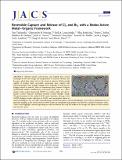| dc.contributor.author | Lomachenko, Kirill A. | |
| dc.contributor.author | Borfecchia, Elisa | |
| dc.contributor.author | Melot, Brent C. | |
| dc.contributor.author | Hudson, Matthew R. | |
| dc.contributor.author | Tarver, Jacob D. | |
| dc.contributor.author | Kagan, Jacob J. | |
| dc.contributor.author | Lamberti, Carlo | |
| dc.contributor.author | Brown, Craig M. | |
| dc.contributor.author | Tulchinsky, Yuri | |
| dc.contributor.author | Hendon, Christopher H | |
| dc.contributor.author | Korzynski, Maciej Damian | |
| dc.contributor.author | Stubbs, Amanda Walcott | |
| dc.contributor.author | Dinca, Mircea | |
| dc.date.accessioned | 2018-01-23T18:52:44Z | |
| dc.date.available | 2018-01-23T18:52:44Z | |
| dc.date.issued | 2018-01-23 | |
| dc.identifier.issn | 0002-7863 | |
| dc.identifier.issn | 1520-5126 | |
| dc.identifier.uri | http://hdl.handle.net/1721.1/113282 | |
| dc.description.abstract | Extreme toxicity, corrosiveness, and volatility pose serious challenges for the safe storage and transportation of elemental chlorine and bromine, which play critical roles in the chemical industry. Solid materials capable of forming stable nonvolatile compounds upon reaction with elemental halogens may partially mitigate these challenges by allowing safe halogen release on demand. Here we demonstrate that elemental halogens quantitatively oxidize coordinatively unsaturated Co(II) ions in a robust azolate metal-organic framework (MOF) to produce stable and safe-to-handle Co(III) materials featuring terminal Co(III)-halogen bonds. Thermal treatment of the oxidized MOF causes homolytic cleavage of the Co(III)-halogen bonds, reduction to Co(II), and concomitant release of elemental halogens. The reversible chemical storage and thermal release of elemental halogens occur with no significant losses of structural integrity, as the parent cobaltous MOF retains its crystallinity and porosity even after three oxidation/reduction cycles. These results highlight a material operating via redox mechanism that may find utility in the storage and capture of other noxious and corrosive gases. | en_US |
| dc.description.sponsorship | National Science Foundation (U.S.) (Award DMR-1452612) | en_US |
| dc.publisher | American Chemical Society (ACS) | en_US |
| dc.relation.isversionof | http://dx.doi.org/10.1021/JACS.7B02161 | en_US |
| dc.rights | Article is made available in accordance with the publisher's policy and may be subject to US copyright law. Please refer to the publisher's site for terms of use. | en_US |
| dc.source | ACS | en_US |
| dc.title | Reversible Capture and Release of Cl₂ and Br₂ with a Redox-Active Metal–Organic Framework | en_US |
| dc.type | Article | en_US |
| dc.identifier.citation | Tulchinsky, Yuri et al. “Reversible Capture and Release of Cl₂ and Br₂ with a Redox-Active Metal–Organic Framework.” Journal of the American Chemical Society 139, 16 (April 2017): 5992–5997 © 2017 American Chemical Society | en_US |
| dc.contributor.department | Massachusetts Institute of Technology. Department of Chemistry | en_US |
| dc.contributor.mitauthor | Tulchinsky, Yuri | |
| dc.contributor.mitauthor | Hendon, Christopher H | |
| dc.contributor.mitauthor | Korzynski, Maciej Damian | |
| dc.contributor.mitauthor | Stubbs, Amanda Walcott | |
| dc.contributor.mitauthor | Dinca, Mircea | |
| dc.relation.journal | Journal of the American Chemical Society | en_US |
| dc.eprint.version | Final published version | en_US |
| dc.type.uri | http://purl.org/eprint/type/JournalArticle | en_US |
| eprint.status | http://purl.org/eprint/status/PeerReviewed | en_US |
| dc.date.updated | 2018-01-19T18:40:55Z | |
| dspace.orderedauthors | Tulchinsky, Yuri; Hendon, Christopher H.; Lomachenko, Kirill A.; Borfecchia, Elisa; Melot, Brent C.; Hudson, Matthew R.; Tarver, Jacob D.; Korzyński, Maciej D.; Stubbs, Amanda W.; Kagan, Jacob J.; Lamberti, Carlo; Brown, Craig M.; Dincă, Mircea | en_US |
| dspace.embargo.terms | N | en_US |
| dc.identifier.orcid | https://orcid.org/0000-0003-3967-3395 | |
| dc.identifier.orcid | https://orcid.org/0000-0002-6577-1821 | |
| dc.identifier.orcid | https://orcid.org/0000-0002-5539-273X | |
| dc.identifier.orcid | https://orcid.org/0000-0002-1262-1264 | |
| mit.license | PUBLISHER_POLICY | en_US |
